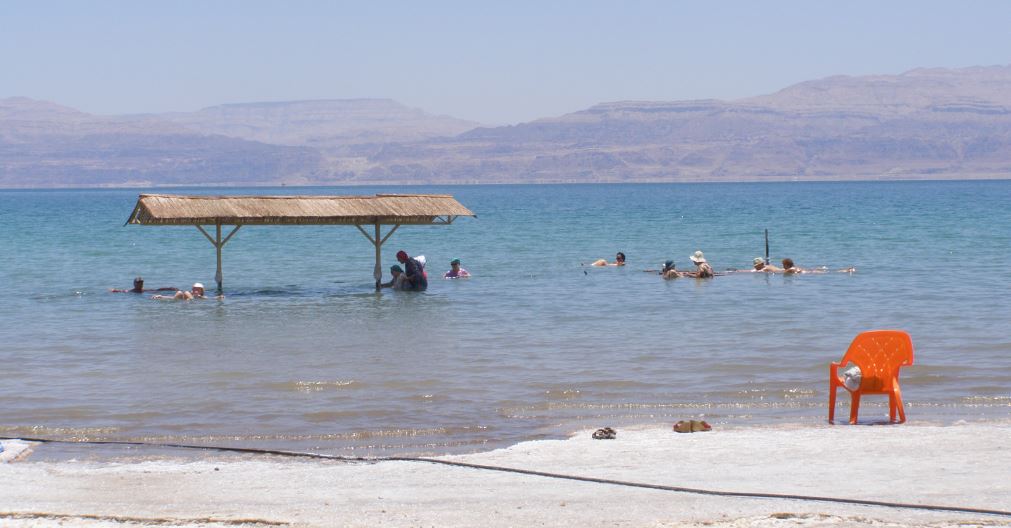Masada is considered one of the “must-see” sites in Israel. Why?
Perhaps it’s so popular due to the striking landscape and geological wonders of the Dead Sea area, the lowest place on Earth. The climb up Masada on the snake path (on the Eastern side) is 1300 feet – at least a 40-minute intensive hike – yet the top of Masada approximately at sea level! The view of the Northern and Southern basins of the Dead Sea, the mountains of the country of Jordan (Biblical Moav) and the Judean Desert is breathtaking. The area is a rich in valuable minerals as it is rich in biblical and historical significance: King David hid out in the Oasis in Ein Gedi, Lot fled from nearby Sodom (there is a pillar of salt rock traditionally called “Lot’s Wife” at the Southern end of the Dead Sea), balsam that was used to make highly valued perfume (called Afarsimon oil) as well as one of the spices for the incense in the Holy Temple grew there, and the Dead Sea Scrolls were found in Qumran.
Perhaps Masada is so popular because it’s interesting to see one of Herod the Great’s building projects; everything he built pushed the limits of nature and technology. In Caesarea, Herod didn’t just build a palace by the sea, he built a palace on the sea. In Jerusalem, he built the largest religious platform in the world when he doubled the size of the Temple Mount, and in Masada, Herod constructed bathhouses, a swimming pool and two palaces, including one off the side of the mountain, in the middle of the desert! It’s amazing to see how flash flood water was channeled from the mountains of Judea, which would get rain in the winter, into large water cisterns halfway down on the Masada horst, and then would be carried up to the top for use. It’s also impressive to see ancient beautiful mosaic floors, frescoes, and Herodian-style plastered walls.
Perhaps people are drawn to Masada for its powerful message. Masada was where the Jewish people of ancient times displayed a strong fighting spirit. They held out to the end against the Romans and refused to accept defeat, choosing a mass murder/suicide over being enslaved or murdered by the Roman forces. In the 1940s, Jewish youth groups would make the long trek to Masada as they built themselves physically and emotionally in order to establish the State of Israel. In our times, many IDF induction ceremonies have taken place on top of Masada with the spirit of “Masada will not fall again.”
But there is another, equally powerful lesson we can learn from Masada. In the year 69, just before Jerusalem was about to be destroyed by the Romans in 70, a rabbi and leader in Jerusalem, Rabbi Yochanan Ben Zakai, pretended to be dead and managed to sneak out of the city in a coffin. He didn’t ascribe to the “fight to the end” philosophy. He was determined, instead, to prepare a plan to save Judaism, even if the focal point of Jewish life, Jerusalem and the Temple, might be destroyed. Once outside the walls of the city, the Rabbi was brought to Vespasian, the Roman General who was sieging the city. After some discussion, Vespasian was so impressed wthat an agreement was made that the rabbi and his other associates could go to Yavne, where they would be imprisoned in a prisoner of war camp but could continue to study Torah (Bible, Jewish law, other traditional studies) together. Vespasian didn’t understand the power of this Torah study. He was interested in the buildings, the walls, the city. He didn’t realize that the rabbis’ learning would form the basis of Judaism to survive thousands of years of diaspora.
When we visit Masada, we can be inspired by all the amazing sites, the fighting spirit, and – with hindsight of 2,000 years – we can see how seemingly contradictory approaches talem by different Jews have all been critical to enabling the Jewish People and State of Israel to be where we are today.
By: Leah Bowman
(The author, a licensed tour guide, leads inspiring tours throughout Israel, including child-friendly and bible tours. Check out her website and blog page.)

Free Ebook: 10 Best Places to Visit in Israel
The Land of Israel has provided the backdrop for some of the most important events in human history. From the Old City in Jerusalem to the Sea of Galilee, people from all over the globe visit the Holy Land each year to take in the breathtaking scenery and inspiration of Israel. Now you can experience this beauty for yourself from the comforts of home and maybe plan a trip of your own to Israel. Get the free, exclusive eBook from United with Israel: The 10 Best Places to Visit in Israel.
Do You Love Israel? Make a Donation - Show Your Support!
Donate to vital charities that help protect Israeli citizens and inspire millions around the world to support Israel too!
Now more than ever, Israel needs your help to fight and win the war -- including on the battlefield of public opinion.
Antisemitism, anti-Israel bias and boycotts are out of control. Israel's enemies are inciting terror and violence against innocent Israelis and Jews around the world. Help us fight back!
